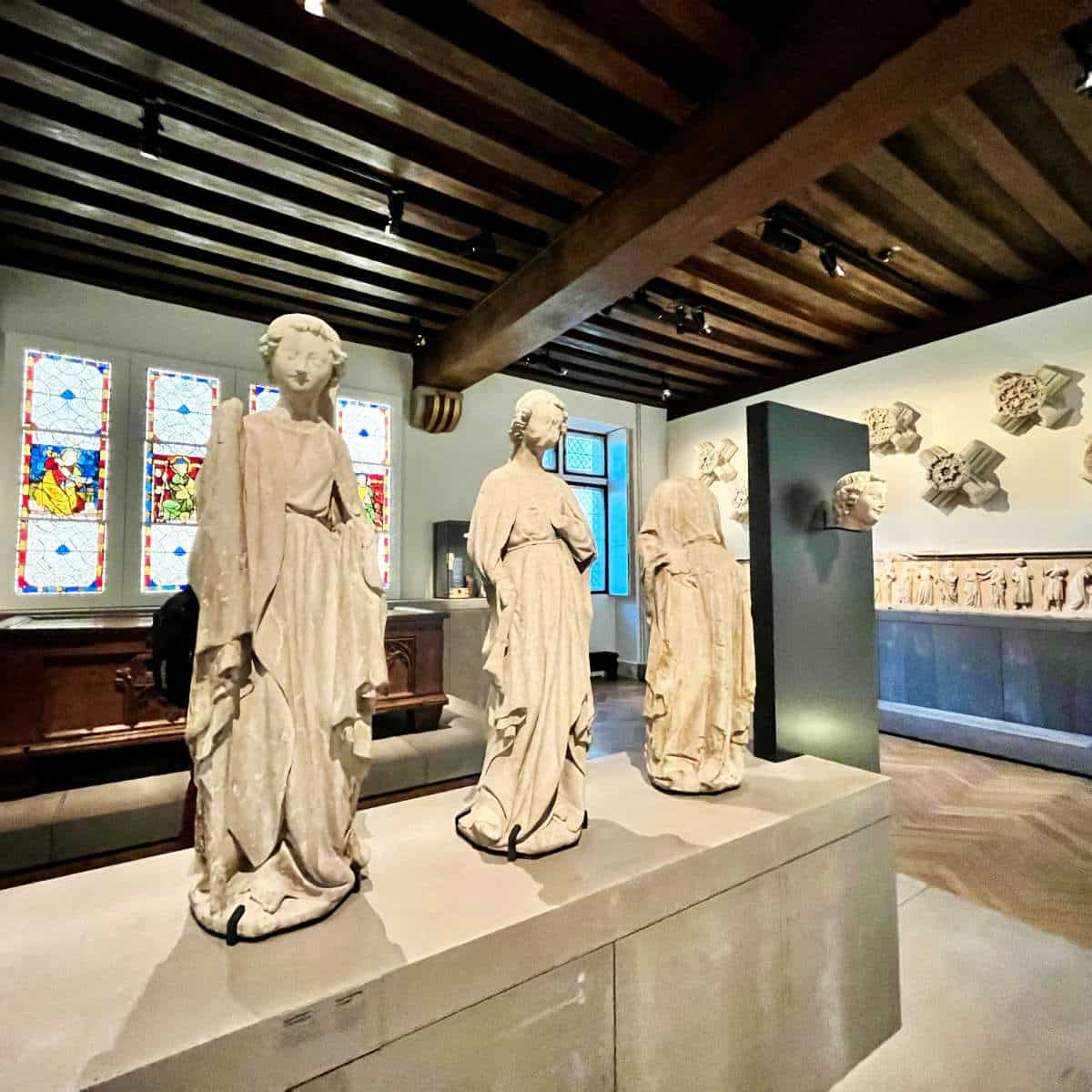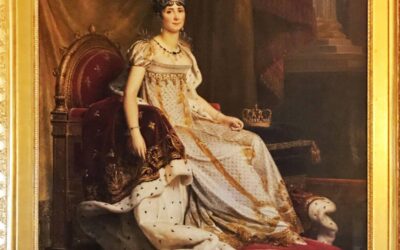The Frankish Empire may not be as famous as the Roman empire but in its heyday, they were the masters of Europe. So how did they become Europe’s movers and shakers? Well, it was a mix of military muscle and diplomatic charm.
After the fall of the Roman Empire, it was the Frankish Empire that was the strongest of the successor states in the west. The Franks were the ones who started off in ancient Gaul, and made the big push to the Atlantic and past the Rhine River.
It all started with Merovech and King Clovis, two chaps who thought, “Hey, why not build an empire?” Fast forward a bit, and we’ve got Charlemagne strutting his stuff, earning the title of Holy Roman Emperor.
That’s right, these Franks weren’t just any East Germanic tribe. They were the big kids on the medieval block. It would be the Frankish tribes that eventually give the country of France its name, marking the history of the country.
And they would set the groundwork for all the future conflicts in Europe between France and Germany.
So, the next time you’re sipping a latte in Paris or chowing down on a bratwurst in Berlin, remember, it’s all thanks to those formidable Franks and their conquering adventures. Let’s find out a few interesting facts and the history of the Frankish Empire, shall we? Allons-y!
- 1. The Frankish tribes emerge during the fall of the Roman Empire.
- 2. Merovech of the Frankish Salians tribe begins the Merovingian dynasty.
- 3. Childeric I accumulates power.
- 4. Clovis I unites all the Frankish tribes.
- 5. Clovis's sons divide the Frankish Kingdom.
- 6. Pepin the Short seizes power.
- 7. Charlemagne would expand the Carolingian Empire.
- 8. Charlemagne's children and grandchildren began to battle.
- 9. The Carlingian Empire gave way to the House of Capet.
1. The Frankish tribes emerge during the fall of the Roman Empire.
The term “Franks” emerged in the 3rd century AD, as noted in Roman records of the time. They were Germanic tribes who settled on the northern Rhine frontier, eventually making their way south.
At the time, there were numerous Frankish tribes in the area that settled the area known as Gaul, under the rule of the Roman Empire which was already in decline.
The main Frankish tribes were the Bructeri, Ampsivarii, Chamavi, Chattuarii and Salians, each of whom co-existed or allied themselves with the Romans to a varying extent.
Due to overexpansion of the Roman territories, economic problems, and a series of defeats to the Visigoths, the Vandals, and the Eastern Empire in Byzantium, the Roman Empire would collapse. This left a large void for the Frankish tribes to gain power in Gaul.
2. Merovech of the Frankish Salians tribe begins the Merovingian dynasty.
Merovech (known in French as Mérovée) was the King of the Salian Franks, which became the most dominent Frankish tribe at the same time as the Romans Empire was declining.
Born around 411AD, not much is known about Merovech. Most of what was recorded was written about him comes from the 6th century historian Gregoire of Tours, who was busy embellishing the past of Merovech’s possible descendant Clovis.
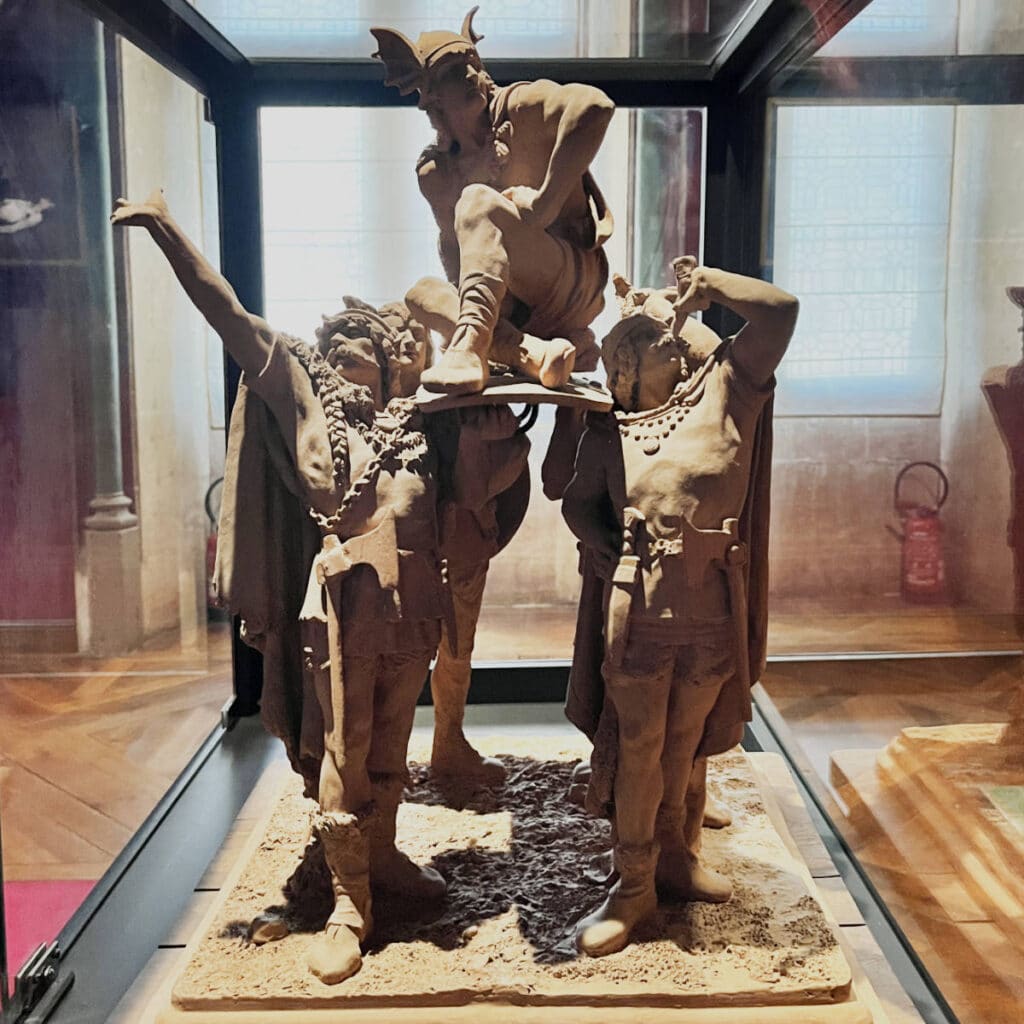
Nonetheless, his name can be translated as “famous in combat” or “famous fighter” from Frankish “mére” meaning “reputation” and “vech” meaning “combat”. So it stands to reason that he was a powerful lord.
Many historians think that Merovech commanded the Frankish tribes while allied with the Roman General Aetius and Visigothic king Theodoric I, to defeat Attila the Hun in 451 near Orlèans.
Merovech would become known as the founder of the Merovingian dynasty, from which his descendants would claim their right to rule. His Frankish Salians tribe would become the dominant tribe through his descendant Clovis, and would claim their right to rule.
3. Childeric I accumulates power.
Childeric I was a Merovingian king of the Salian Franks tribe, and the son of Merovech. He was married to Basina, a Thuringian princess from a Germanic tribe.
Childeric became an important ally for the Roman domain of Soissons, defeating the Visigoths in 463, as well as a Saxon attempt to settle around the Atlantic coastline.
Childeric I died in 481AD, leaving the throne to his son Clovis who was 15 years-old.
4. Clovis I unites all the Frankish tribes.
Clovis I was the first king of the Franks to unite all of the Frankish tribes under one ruler in 481 AD.
He began by conquering neighboring territories, while at the same time entering into alliances to expand his base support. His conquests ensured that the monarchy was passed down to his heirs, as part of the Merovingian dynasty in France.
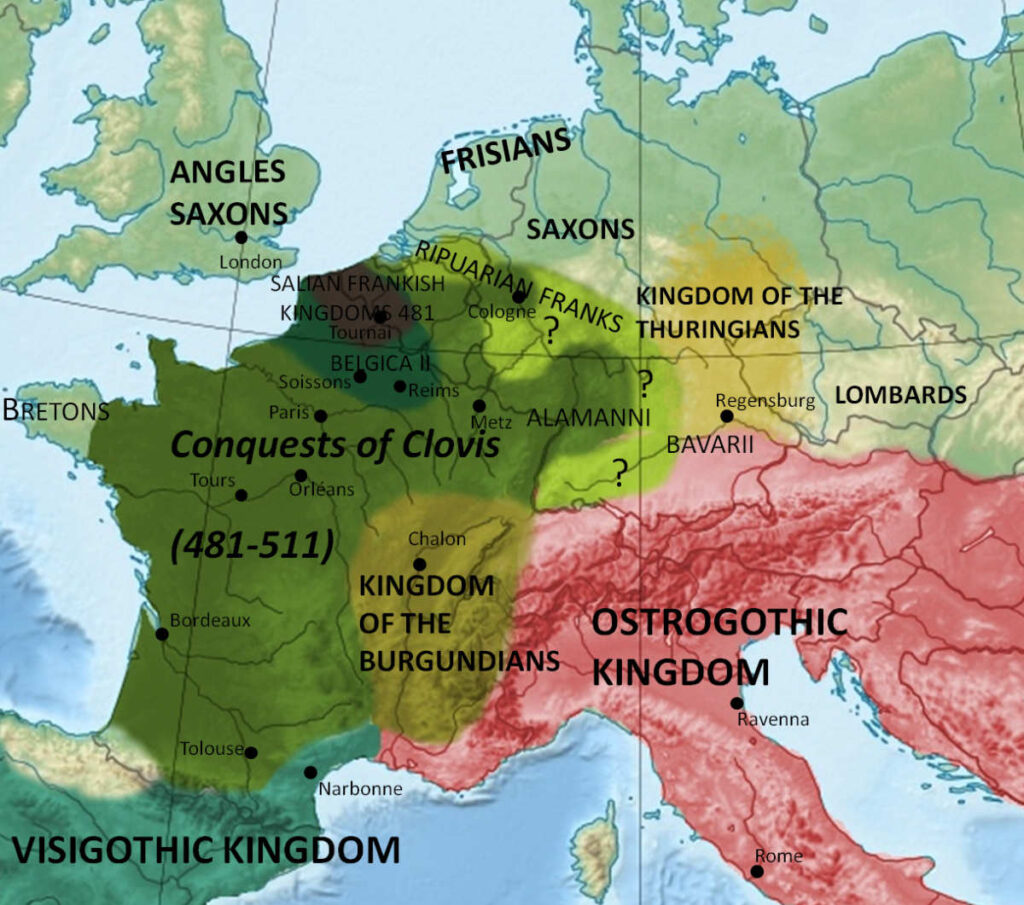
He would go on conquer much of ancient Gaul, establishing the rough outlines of what would become known as France. It is Clovis I who establishes Paris his capital in 508AD on Ile de la Cité, because of its strategic position on the River Seine.
Importantly in 493AD, Clovis decided to marry a local princess named Clotilde who was from Lyon.
She was a devout Catholic who would convince Clovis to convert to Christianity and reunite the various Gallic and Frankish tribes. Because she was Catholic like the Romans, this ensured that Clovis became Catholic.
Clotilde would be proclaimed a saint, along with a local nun named Genevieve who also was advising Clovis. Genevieve would become the patron saint of Paris.
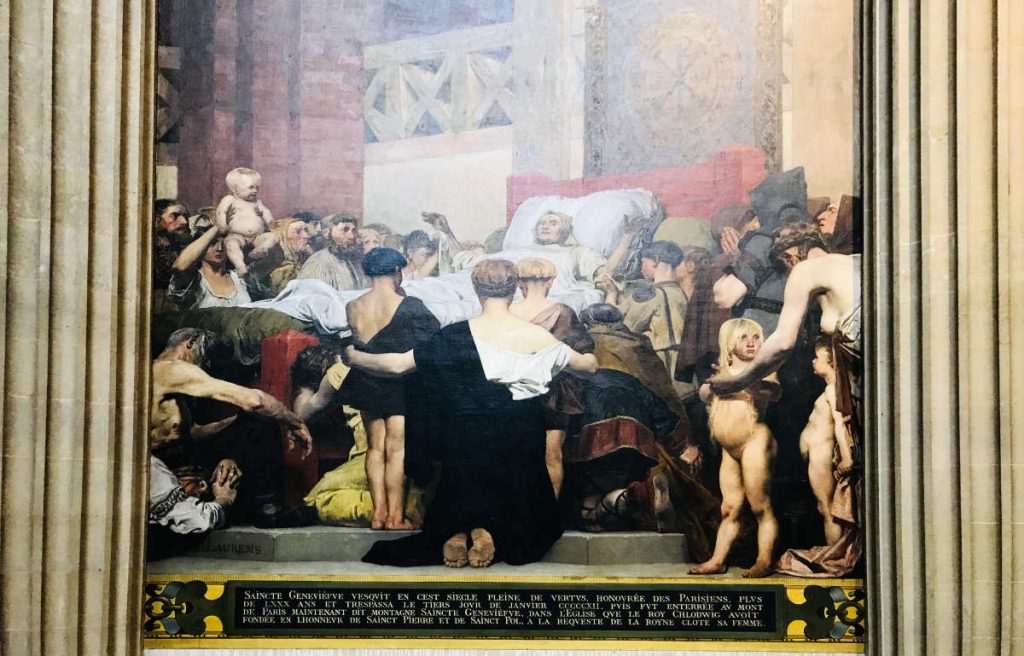
The fleur de lys which symbol of the French monarchy is thought to represent Clovis’s conversion to Christianity.
Clovis’s Christianity meant that he had the support of the Byzantine Roman Empire who were also Catholic in his wars against his rivals. It would lay the foundation for the country we now know as France.
5. Clovis’s sons divide the Frankish Kingdom.
Clovis I is believed to have died on November 27, 511AD at the age of 45 after a short illness. Upon his death, his kingdom was divided amongst his 4 surviving sons as was the tradition at the time, to try to continue the Merovingian dynasty:
- Theuderic – Rhine and Champagne regions, capital in Reims
- Clodomir – Loire, capital in Orleans
- Childebert I – Normandy, capital in Paris
- Clotaire I – North of Gaul, capital in Soissons
All four set up their respective capitals a short distance from each other, which was meant to help maintain the unity of the kingdom.
6. Pepin the Short seizes power.
Pepin the short (also called Pépin le Bref) was born in 714 and was the younger was the son of the Frankish prince Charles Martel and his wife Rotrude.
Pepin was initially designated as “Mayor of the Palace”, which was a managerial position in the household of the Frankish King Childeric III of the Merovingian dynasty, who was a descendant of Clovis.
At the time, much of the tribes of the Franks had been Christianised, due to the Catholic conversion of King Clovis a couple of centuries earlier. With the agreement of the Pope, Pepin the Short deposed Childeric III to be declared King himself.
Pepin the Short and his wife Bertrada of Laon were closely related, and thus had trouble having their marriage officially recognized. Nonetheless, they had a son, believed to be born 2 years before their marriage, who they named Charlemagne.
7. Charlemagne would expand the Carolingian Empire.
They say that every European is related to King Charlemagne. Charlemagne was born around 747AD and would become a legend for building what became known as the Carolingian dynasty.
Pepin the short had divided his lands between his sons as was the tradition, but Charlemagne had other ideas. After disposing off his brother, Charlemagne had conquered almost the entirety of the area known today as France and Germany by 768 AD.
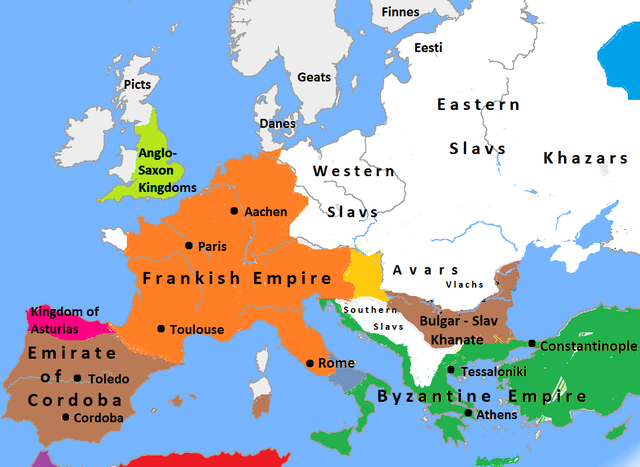
A large portion of Europe had by now become Christian. By 800AD, Charlemagne was one of the most powerful rulers in Europe. The Catholic Pope Leo III was looking to break ties with the nearby Byzantine Empire and came to Charlemagne for protection.
Pope Leo III crowned Charlemagne with the title “Holy Roman Emperor” on Christmas day 800AD in Old St. Peter’s Basilica in Rome. The Frankish Empire was now at its height.
8. Charlemagne’s children and grandchildren began to battle.
Charlemagne died in 814 at the age of 66. He had 23 children, among them many sons, amongst whom he decided to carve up his empire.
Upon his death, his sons started squabbling. By 842 AD, two of his grandsons, Louis of East Francia (Germany) and Charles of West Francia (France), decided to sign a treaty called the Oath of Strasbourg.
Their goal was to oppose their older brother Lothair of Middle Francia. It was the start of the many wars fought in this region, of what is now Alsace, between France and Germany.
9. The Carlingian Empire gave way to the House of Capet.
With Charlemagne’s descendants all fighting amongst themselves, and it was through a great-grandaughter of Charlemagne that the throne would pass.
Born in 941, Hugh Capet was descended from Charlemagne’s sons Louis the Pious and Pepin of Italy through his mother and paternal grandmother respectively.
He was also a nephew of Otto the Great, the Eastern Frankish King of what would become Germany. (It was Otto who would become Holy Roman Emperor, following in Charlemagne’s footsteps.)
In 987, Hugh Capet was elected as the successor of the last Carolingian king, Louis V. He would become the founder of the powerful House of Capet. It is the start of what historians regard the beginnings of modern France.

If you enjoyed that article, you may like to read more about the history of France. A bientôt!
